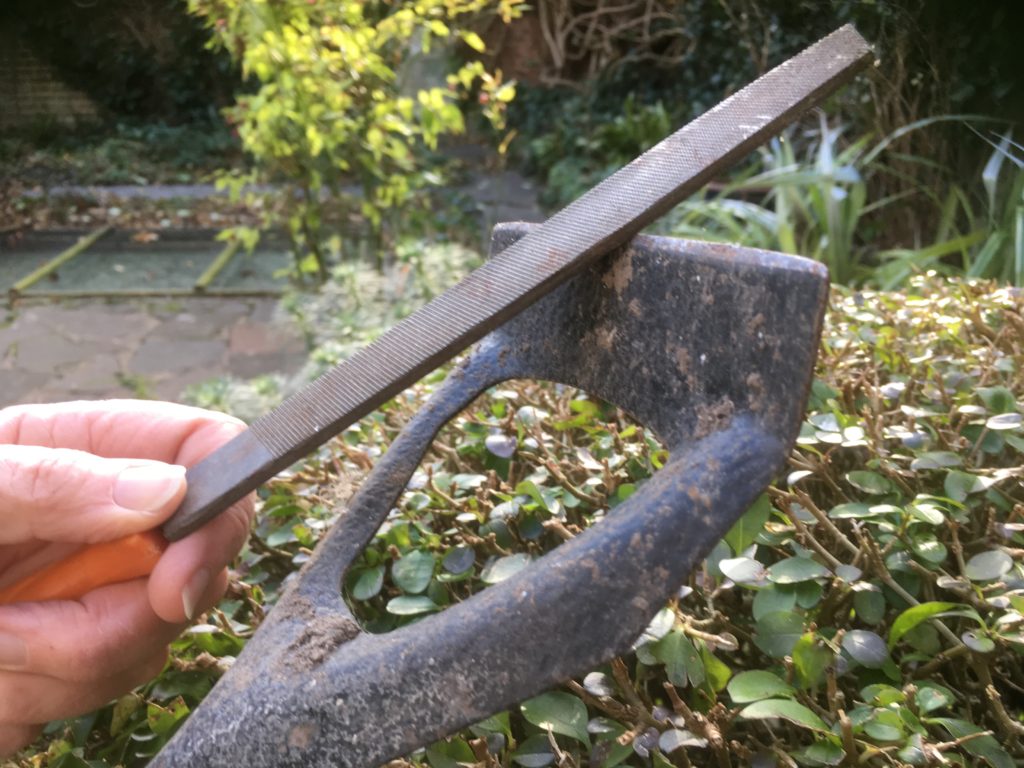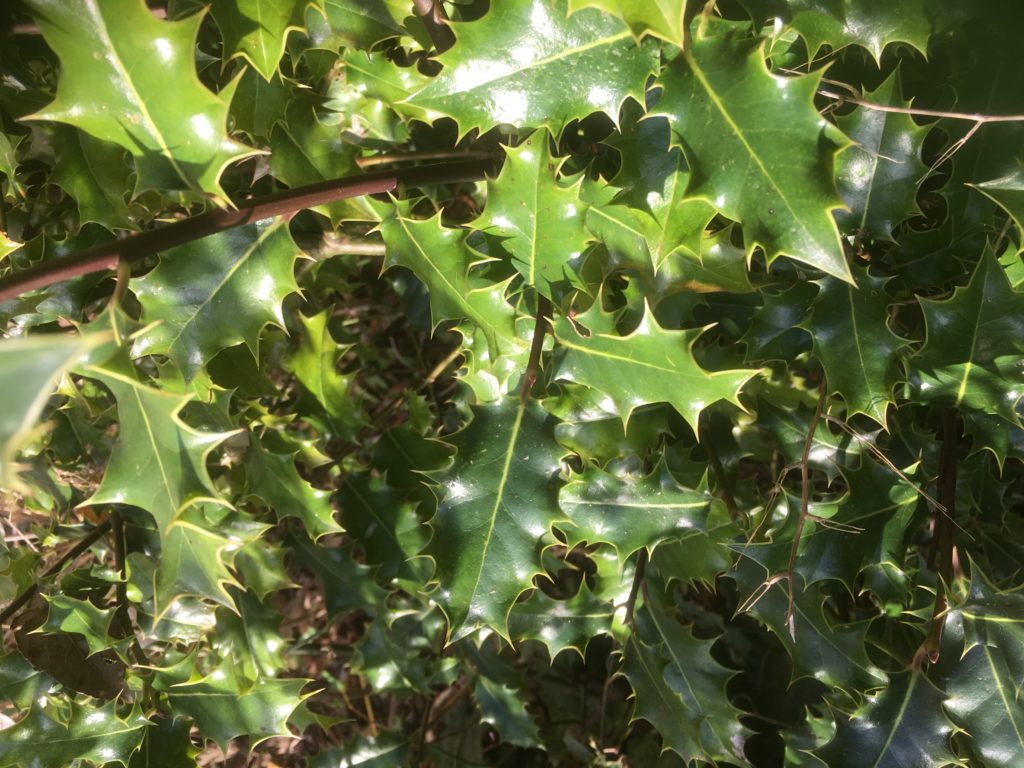
How to plant lily bulbs and how to crown-lift evergreen trees, as well as get some soul-improving tool maintenance done – these are the tasks I’m covering this week. So take a break from the hectic Christmas shopping and menu-planning, and escape into the garden for a bit….
LOVELY LILIES FOR YOU
If the ground isn’t frozen, now is a good time to plant some lilies in a sunny place (though it’s even better if their roots are in shade, and their heads are in the sun), to bring beauty and scent next year. First of all, don’t buy dried-out bulbs – they should be plump and luscious. They are happiest on a neutral to acid, free-draining soil, so dig in some grit or sharp sand if the earth is inclined to be heavy and damp.

Now, planting depth. Stem-rooting lilies like the Turk’s Cap Lily (L. martagon) or (my absolute favourite) L. regale must be planted deeply – at least three times the height of the actual bulb. Oriental lilies root from the base of their bulb but also like to have at least twice their height of soil above them, while the Madonna lilies (L. candidum) or L. testaceum, can be planted at a more shallow depth – really just under the surface of the soil. A rough guide to the distance between them is three times their diameter, but the Oriental kinds can tolerate being planted much more closely together, and that’s why they are the best lilies for pots. Label the spot, and cover it with another layer of grit, to deter those wretched slugs and snails a bit.
LIFTING THE CROWN
No, I don’t mean something that Prince Charles dreams about; this is a hugely useful activity for giving access to the ground beneath a tree, allowing light to penetrate to this area, and giving you more planting space beneath. Crown-lifting involves cutting the lower branches of an established tree, while retaining the top (‘crown’).

The received wisdom is to leave at least two-thirds the total height of the tree, but to take off those annoying lower limbs that you have to bend double to walk or mow beneath – you frequently see it being done during the winter on street or park trees to allow greater access. I think this treatment makes a tree look much more…..tree-like, and gives it a satisfying, even noble, shape. And I love the fact that it gives me a chance to plant all sorts of bulbs underneath it, with a greater possibility of success. I’ve done it with all sorts of trees, including evergreens.
The basic technique is simple – use a sharp pruning saw, loppers or secateurs to cut branches and stems flush with the main trunk or big upright-pointing lower branches. Don’t paint ‘wound-paint’ on the cut areas – this is a discredited idea these days, more likely to seal in infection rather than discourage it. The only major caveat is that if you want to take off some really major stuff, don’t do it all in one hit. That can cause decay in the main trunk which could be a disaster. Take some of the branches off, but leave the rest on for at least another year before carrying on with the job.
SHARP PRACTICE
Now come on, be honest – do you actually clean and oil all your garden tools after every use? I thought not. And neither do I. And yet we expect them to serve us perfectly throughout the whole of the growing season with never a squeak of inefficiency! So, while it’s pelting or freezing outside, give a Christmas present to your spades, forks, trowels, hoes, loppers, shears and secateurs (even your scythe, Poldark!) and sharpen them up. My tool-shed is pretty damp, so I keep any bladed tools in a tub of oily sand, but they still need some TLC occasionally. Blunt cutting edges on any garden tool results in bruised, snagged stem-edges, inaccurate cuts inviting infection, and more effort for your poor fingers and arms.

First of all, clean them up using a wire brush, wire wool or a nylon scourer, scrubbing off the rust, dirt or plant sap ( a cloth soaked in white spirit will shift tough dirt). Then sharpen them up using a whetstone or a file. Finish the job by wiping the implement with an oily rag, which will stop rust forming and keep any moving parts working smoothly.
And just think of the warm, smug glow you’ll have when you’ve done them all!!!
GARDENING SHORTS
* If you have evergreen shrubs growing in pots, do make sure you keep them watered – cold winds can quickly desiccate their foliage.
* Order your seed potatoes now. There are so many lovely varieties to choose from, and you will get the best choice!
* Are you stuck with a holly that has no berries for your festive house decorations? It means that it’s a male; only the females have berries, and be careful, because ‘Silver Queen’ is a male, and ‘Golden King’ is a female – bonkers, eh? Now is a good time to check out varieties at a good garden centre that DO bear berries, as well as sniffing out some winter-scented shrubs, as you plan for the fabulous garden you’ll have in the future.

NB If you’d like a bit more gardening chitchat from the3growbags, please type your email address here and we’ll send you a new post every Saturday morning.

3 replies on “Lilies, tree-shaping and tool care – tips for December”
Remember when you grow Lilies and Fritillaries to keep an eye out for the dreaded red lily beetle. They only lay their eggs on the leaves of these two bulbs and the nasty grubs (I shall not tell you how they hide) not only spoil the leaves but also can result in smaller bulbs in future years. Vigilance is the key from late March. They are easy to spot but if you are not careful they drop immediately to the ground and are then difficult to find, so you need to place your hand under the beetle and catch it and I am afraid squash it immediately. Do not be squeamish about this remember they are pests.
Thanks for the reminder about these little blighters Jenny, and with global warming they seem to be appearing in my garden earlier and earlier each spring, that was about the only good thing about the beast from the east last year- it seemed to keep them at bay for a while. Happy Christmas! Laura x
You are so right, Jennie, horrible things! These red beetles were the subject of a Growhow topic a while ago, when I mentioned that laying a white sheet of paper on the ground underneath the plant before you try to pick them off, will help you to find them when they drop. Have a super Christmas and New Year! Elaine